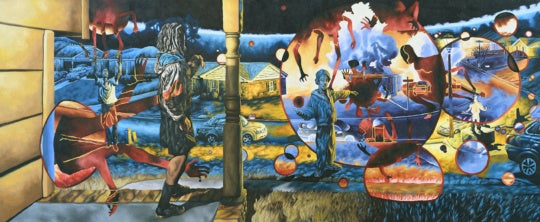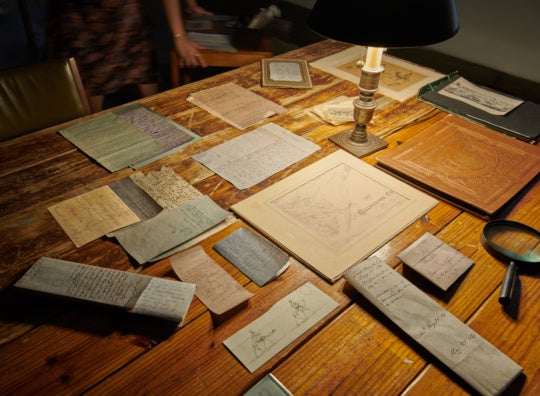
“Dirty South,” which closes tonight (7-11pm) at Mammal Gallery, brings together the work of 10 Southern artists who explore the South’s seedy underbelly though various lenses, including race, gender, and sexuality. The topic is broad, to be sure, but why impose limits? Just like the South, dirty can have oh-so-many faces.
One of the first images of the exhibition is Tyrus Lytton’s An All American Breakfast Story. It’s painted in a flat, precise style that reveals Lytton’s technical proficiency. Indeed, Lytton’s graphic style is a departure from his earlier, old master–style chiaroscuro. The painting’s subject is aggressive: tied to a tree, a light-skinned black woman is draped in an American flag, though she is uncovered strategically to reveal a faint tan line. She looks back at the viewer with a self-aware gaze reminiscent of Manet’s Olympia. It’s hard to imagine that Lytton didn’t have the French painter’s well-known work and its various associations in mind. Seeing a woman, and for that matter a woman of color, presented in this way, right now, is unsettling to say the least. Yet Lytton’s title suggests a serious, even critical, take on the subject: we’re fed this kind of thing (sexualized female bodies) on a daily basis and in so many ways we can become immune.
Drék Davis deconstructs the South’s unseemly deeds head-on with a subversive wit made all the more potent by his complex forms and tight craftsmanship. Made of meticulously cut paper, fabric, and other materials, CruciPorn confronts Southern Christianity like Madonna in the ’80s. A tall, black Latin cross has a detailed vagina superimposed on a penis; the cross’s arms form the Confederate flag’s stars and bars; and Scarlett O’Hara’s visage—a Southern false idol par excellence—is cut out of the cross’s center. Davis’s other works, like Dicksy, reiterate the theme. The intersecting bars of Dicksey are formed from phallic shapes that echo the title’s clever pun, as if to say: yeah, that flag is kind of for racist dicks.

Adjacent to Davis’s iconoclastic and graphic CruciPorn, Lauren Alyssa Howard’s elegantly rendered drawings are as meticulous as Davis’s work. Yet, Davis’s is bombastic and baroque, while Howard’s is subtle and soft-spoken—but that doesn’t mean she can’t carry a big stick. Her drawing, Apathy Begets Apathy ( … or something like that), shows a ferocious, half-feline creature stretching her toothy jaw open as if to eat a placid-faced woman wearing an animal mask. Undoubtedly a metaphor of lethargy’s tendency to propagate itself, Howard’s work nonetheless has undertones of the mythical Pasiphae’s bestial sexuality.

Howard’s rendering style might be indicative of larger trend within the group show: unflinching naturalism is one thing that many, but not all, of the artists share. For example, Jeremy Hughes’s series of small drawings consists of portraits of friends and acquaintances alongside feminine types lifted from the media—Maleficent and Actress out of Work, to name a few—positioning real women alongside impossible archetypes. Hughes’s paintings, like the aptly named Fauxllatio, are a bit filthier, perhaps. Though Dirty South is heavy on drawing and painting, much of its two-dimensional work has a mellower take on the theme. Kent Knowles’s large and lush painting, Big Danger, and his drawings on small, premade china have a magical realist sensibility. John Stidham’s Hopper-esque series of three paintings, collectively called Dirty South, have a noir sensibility that suggests rather than tells a story.
The work of Eric Hancock, Zachary Herrmann, and Justin Rabideau bring a needed, less literal, material sensuality to Dirty South. Hancock’s paintings Rudder and Employee of the Year are soft and diffused, recalling 20th-century modernist abstraction. Similarly, Hermann’s collages on paper Oasis and Meteor, or his small sculpture (o), are neon-hued and nonobjective, distilling the seduction of color and form to their basic components. Rabideau’s Shim 7 and Shim 8 are sculptures made of salvaged wood, a material ubiquitous in a lot of new Southern architecture. As such, Rabideau’s sculptures not only belong to the present zeitgeist but also echo the show’s basic impetus: to reclaim and restore.

Joni Younkins-Herzog’s Peckerhead Barbie—one of three variations of the theme included in the show—is a psychoanalytic totem cast in bronze: though the doll’s long legs are intact, her body has been replaced by a phallic form, as if to make literal the Freudian notion that men who experience fear of castration fetishize the entire female body as a—well, you know. There are other ways to read these works, of course; so the final verdict goes to you. Situated at the center of the gallery, they’re apt conversation starters for a diverse and dirty show. Indeed, Herzog’s sculptures seem to encapsulate the problem of women and representation probed but never fully reconciled in an exhibition that is otherwise compelling and irreverent.
Rebecca Brantley lives in Athens, Georgia, and teaches for Piedmont College and the University System of Georgia. She is board president at ATHICA: Athens Institute for Contemporary Art. She was a participant in the first cycle of BURNAWAY’s Emerging Art Writers Mentorship Program.




